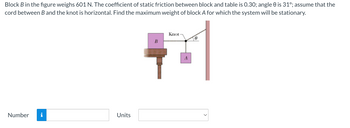Question

Transcribed Image Text:Block B in the figure weighs 601 N. The coefficient of static friction between block and table is 0.30; angle 0 is 31°; assume that the
cord between B and the knot is horizontal. Find the maximum weight of block A for which the system will be stationary.
Number
Units
B
Knot
A
0
>
Expert Solution
This question has been solved!
Explore an expertly crafted, step-by-step solution for a thorough understanding of key concepts.
Step by stepSolved in 2 steps with 2 images

Knowledge Booster
Similar questions
- What is T?arrow_forwardPart B As shown, a truss is loaded by the forces P₁ = 497 lb and P₂ = 198 lb and has the dimension a = 9.40 ft. H M B с ** FCG, FGH = a/2 a/2 P₂ Determine FCG and FGH, the magnitudes of the forces in members CG and GH, respectively, using the method of sections. Assume for your calculations that each member is in tension, and include in your response the sign of each force that you obtain by applying this assumption. Express your answers numerically in pounds to three significant figures separated by a comma. ▸ View Available Hint(s) E 195] ΑΣΦΗ 41 | vec SWED ? lbarrow_forwardIn the figure, block A (mass 13.2 kg) is in equilibrium, but it would slip if block B (mass 7.40 kg) were any heavier. For angle 0 = 29.6°, what is the coefficient of static friction between block A and the surface below it? Number i Unitsarrow_forward
- P1a please help me with the answer and full solutionarrow_forwardIn the figure, two blocks are connected over a pulley. The mass of block A is 5.80 kg and the coefficient of kinetic friction between A and the incline is 0.360. Angle e of the incline is 31.0°. Block A slides down the incline at constant speed. What is the mass of block B? Frictionless, massless pulley B. Number i Unitsarrow_forwardThe tolerance is -+1 in the 2nd significant digitarrow_forward
arrow_back_ios
arrow_forward_ios